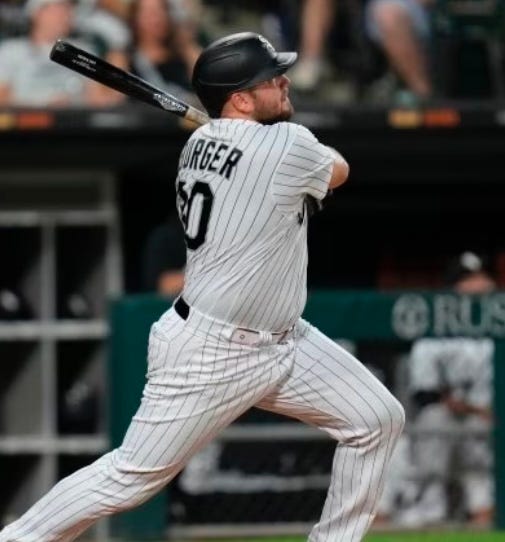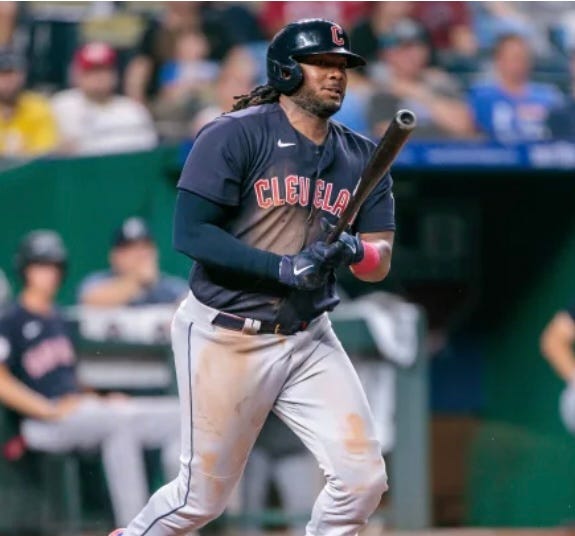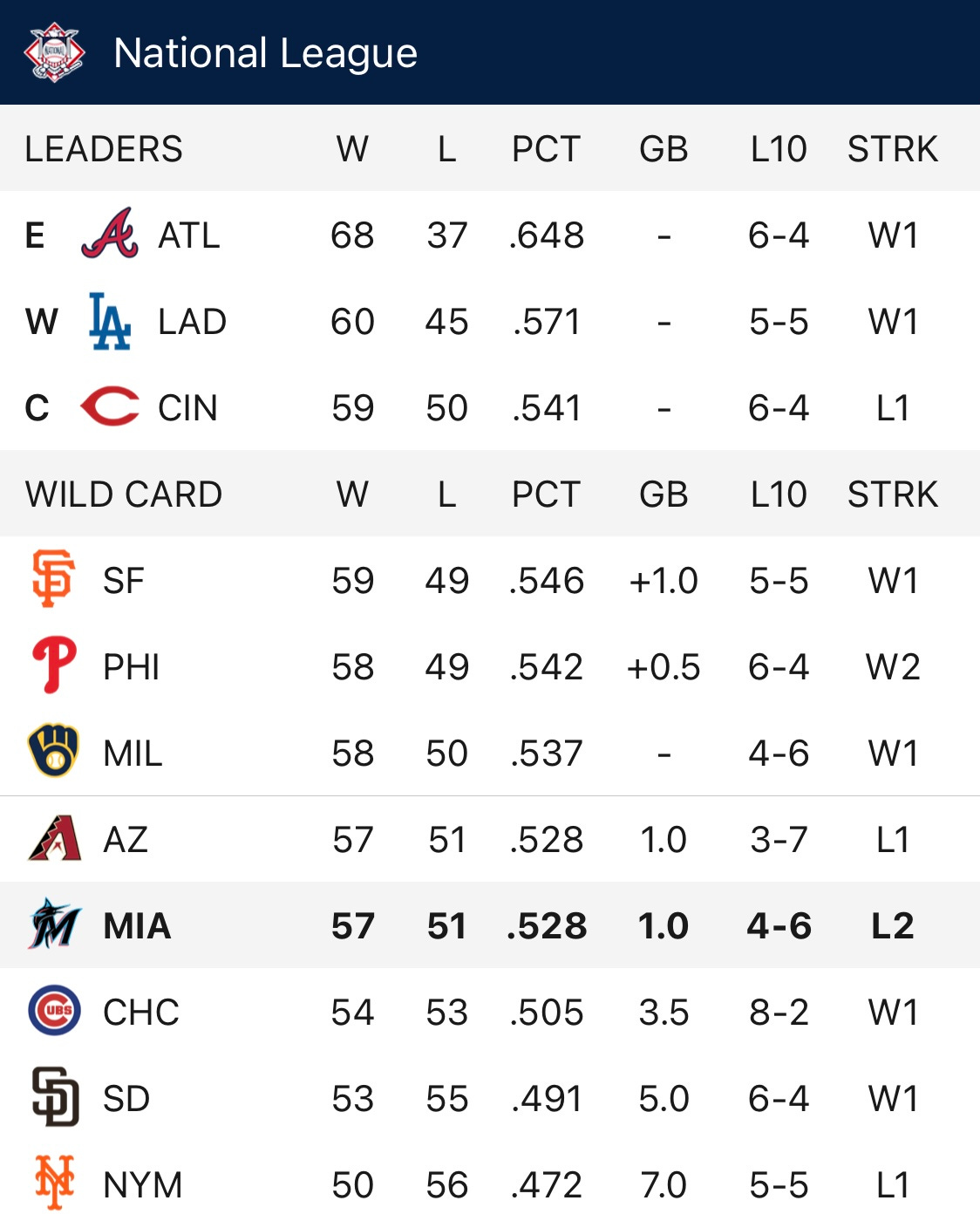

The Marlins would seem to be a better team coming out of the trade deadline than they were going in. And that’s a good thing.
Last week, they acquired a pair of bullpen arms, an established major league closer in David Robertson (last night’s blown save notwithstanding) and a serviceable veteran in Jorge Lopez.
In Jake Burger and Josh Bell, they added 2 infield corner power bats to a lineup that, since Bruce Sherman blew up the roster he inherited in 2017, ranks dead last in MLB in runs scored and home runs over the last 6 seasons and is near the bottom of the majors in both categories again this year.
And they added a pedigreed pitching question mark in 23-year-old Ryan Weathers, who—with some luck—could turn into a Jesus Luzardo-like project for Mel Stottlemyre Jr.
In a dogfight to reach the playoffs in a full season for the first time in 20 years, and trying desperately to make fans in South Florida care (announced crowds of fewer than 10,000 for critical games against the rival Phillies the last 2 nights should not be taken as an encouraging sign), the club paid a price in prospects and dollars to consummate these deals. But that’s accepted practice among teams that are actually trying to win.
The key is the Marlins surrendered nothing off their ML roster except for Jean Segura, who contributed little in his 2/3 of a season in Miami and was immediately released by the Guardians despite having about $13 million left on his contract through 2025, and Garrett Cooper, who went to San Diego in the Weathers exchange (which for him is also a weather exchange). Until yesterday the longest-tenured Marlin, there was a feeling among many in the front office and the clubhouse that it was time for Cooper to…uh…have the chance to take advantage of a fresh start somewhere else.
So the Marlins improved their major league roster without subtracting from it in a meaningful way.
But I’m still left with several questions as general managers across MLB not named Billy Eppler begin to stir from their first good night’s sleep in a couple of weeks.
First, what happened to improving the starting rotation? They needed to. Kim Ng had said she hoped to. But they didn’t. I’m not going to run through the reasons why this was a vital need again. I’ve written about it often, and I’ll refer you to my VIEW FROM THE BLEACHERS archive. Check out what I wrote July 4. Or this from last week.
This organization does not have the major league-ready pitching depth many think it has. And signs point to this organization not having the reliable major league rotation, top to bottom, to get them through the next 2 months and October (if they make it that far). To get to the playoffs, it was my belief they needed to upgrade the rotation in a meaningful way.
Many playoff contenders did. The Marlins did not.
Then there’s this question I can’t help but ponder: Do the Marlins have a coherent plan to which they are committed, or are they simply making it up as they go?
Remember when Sherman and Derek Jeter took over how they were going to build around freakish athletes. That’s how we ended up with Monte Harrison, Lewis Brinson, Magneuris Sierra and Jazz Chisholm. That’s why they spent first-round picks on Connor Scott and Kahlil Watson, the latter of whom was sent to Cleveland in the Bell deal yesterday after 3 uncomfortable low-level minor league seasons.
They told us they were going to have an outfield full of center fielders and an infield full of shortstops.
It sounded great in theory
But at some point, folks realized that dunking a basketball and being able to outrun a high school defensive back on a go route doesn’t necessarily mean you can play baseball.
Finally someone saw the light. Instead of raw free swingers with light-tower power at 4:30 in the afternoon, sky-high strikeout rates at 7:10 and limited instincts for the game, this past winter we heard they needed more contact hitters, guys who would put the bat on the ball, take advantage of the newly imposed shift restrictions, hit for a high average and avoid strikeouts.
That’s the profile they expected Luis Arraez, Jean Segura and Yuli Gurriel would bring to the club. Arraez, at least, has delivered.
Now the slow-footed contact-heavy Marlins are the run-away major league leaders in hitting into double plays, leaving front office people to take members of the media aside throughout the year to pitch them the concept that the double plays are acceptable because they’re a byproduct of striking out less. Their glass-half-full approach is that more contact leads to more double plays. Still, do you feel better when they have runners at first and third and one out in a tight game and a strikeout would actually be better for the team than the double play that gets the opponent out of the inning?
That’s a round-about way of getting to this: We’ve gone from free-swinging, high-strikeout athletes to higher-contact, higher-average professional hitters to, now…Jake Burger and Josh Bell?
Yes, Burger has 25 home runs in one of the most hitter-friendly home parks in MLB on the South Side of Chicago. He has power to all fields, and he consistently hits the ball hard.
When he hits it, that is.
You see, he’s also a .214 hitter with a .279 OBP and a .225 BABIP (despite all his hard contact). Alarmingly, he strikes out in 31.6% of his plate appearances, the 6th-highest rate in MLB among players with at least 300 plate appearances. By way of comparison, even Jazz Chisholm only strikes out in 31.0 percent of his plate appearances.
So, yes, Burger will run in to some. But he’s also a low-average, low OBP strikeout machine whose best position is designated hitter, where the Marlins have Jorge Soler.
As Keith Law wrote in The Athletic about Burger replacing Segura, “It’s like adding the same guy but with the potential for 10 homers the rest of the way instead of one or 2.”
As for Bell, he was a spare part for the Guardians after they acquired prospect first baseman Kyle Manzardo from the Rays in exchange for righthander Aaron Civale.
He’d had some big years in Pittsburgh and as recently as 2021 in Washington. He was off to a good start for the Nats last year before falling flat when he was sent to the Padres at the deadline as part of the Juan Soto trade. With the Guardians this year, he was batting just .233/.318/.383/.701 with 19 doubles, 11 homers and 48 RBI in 97 games. While his 2023 home run and walk rates are near career-lows, his strikeout rate is the highest of his 8 ML seasons.
2021 Josh Bell would be a great pick-up. We’ll see if that’s the guy who gets off the plane at MIA.
So both Burger and Bell are upgrades over what they had, but are either of them truly game changers?
Are marginal upgrades at some prospect and financial cost enough to get this team to the playoffs?
I will not criticize the Marlins for trading prospects to bring in players they hope will help get them to October.
But, if they don’t make the playoffs—and their odds, according to Fangraphs, are down from 74.4 percent at the All-Star break to 40.8 percent this morning after last night’s loss to the Phillies—there’ll have to be some regret.
The Marlins traded 2 very young but promising prospects to the Mets for 1/3 of a season of rental closer David Robertson, who will be a free agent at the end of 2023.
While Burger is under club control through 2028, he cost the Marlins their #2 overall prospect, according to Baseball America’s mid-season ranking, right-handed pitcher Jake Eder, the Vanderbilt product who was at Double-A in his return from Tommy John surgery in 2021.
And in acquiring Bell, the Marlins sent Kahlil Watson to the Guardians. While the club’s mid-season #11 prospect per MLB Pipeline has not hit in 3 minor league seasons, he’s still only 20-years-old and was the club’s #1 pick (16th overall) in 2021.
Of the 6 players the Marlins took in the first round of Sherman’s first 4 drafts (2018-21), 4 have been traded (Connor Scott, Kameron Misner, JJ Bleday and now Watson), while a 5th, Max Meyer, is rehabilitating from 2022 Tommy John surgery. The 6th is catcher Joe Mack, taken 31st overall in 2021. He’s batting .213 with a .538 OPS in 88 games at high-A Beloit this season and has batted .214 with a .621 OPS in 151 career pro games.
I’ve said it before: Between a limited number of graduations to the big leagues, several players being traded away, some enduring significant injuries, some whose performance has soured evaluators and some scouting and/or player development misses, the Marlins’ farm system is a shell of what it was perceived to be a couple of years ago.
The moral of the deadline: They desperately need to hit on these trades, and they really need to make the playoffs. Otherwise, their potential upgrades may have merely dug the hole deeper
NOTHIN’ BUT THE TAILLIGHTS
They were never going to catch the Braves, but last night’s Marlins loss, coupled with Atlanta’s win over the Angels, means the Marlins are now a season-high 12 1/2 games behind the division leaders in the NL East.
As of last night, Miami is, in fact, closer to the last-place Nationals in the standings than they are to the division-leading Braves.
A major league-worst 4-12 since the All-Star break, the Marlins are 12 games in front of the cellar-dwelling Nats.
STATE OF THE RACE
Far more important than where they are in relation to Atlanta is that, after leading the race at the All-Star break, the Marlins are now tied for 4th in the pursuit of one of 3 NL Wild Card spots. And don’t look now, but the Cubs and Padres are making a move in the rear-view mirror.
And remember, in the event of a tie, the head-to-head season series result is the first tie-breaker. With losses the last 2 nights, the Marlins are now 4-4 against the Phillies, against whom they’d previously held the edge. These head-to-head games are critical.
While you’re here…
Learn more about one-on-one play-by-play coaching from Glenn Geffner via Zoom at glenngeffner.com.
Your feedback is always appreciated. Hit the “LIKE” button below if you enjoyed this post.
Ideas for future posts? Please share them in the Comments.
Interested in advertising on VIEW FROM THE BLEACHERS? Email me at glenn@glenngeffner.com.




I have enjoyed the improved Marlins (and yes, I know the schedule and Eury 's improbable performances were keys). As you counseled on several occasions, we fans should acknowledge the progress and be realistic, if understandably hopeful. Some moves were necessary for both the WC run, even if increasingly unlikely, and Sherman's partial rehabilitation. Today, Saturday, we saw more of your prescient statements. Soriano started (thin pitching), Chisholm left hurt again (the team's shaky Jazz cornerstone strategy), and second straight series loss (rough second-half schedule). Still, a lot more entertaining and feisty team in Skip's first year. OK.
Your assessment is a little discouraging Glenn. It sounds correct though. It ain’t easy being a Marlins fan. But, as last weekend showed, give us a competitive team and the fans will show up. Of course Miggy’s farewell tour played a huge part.